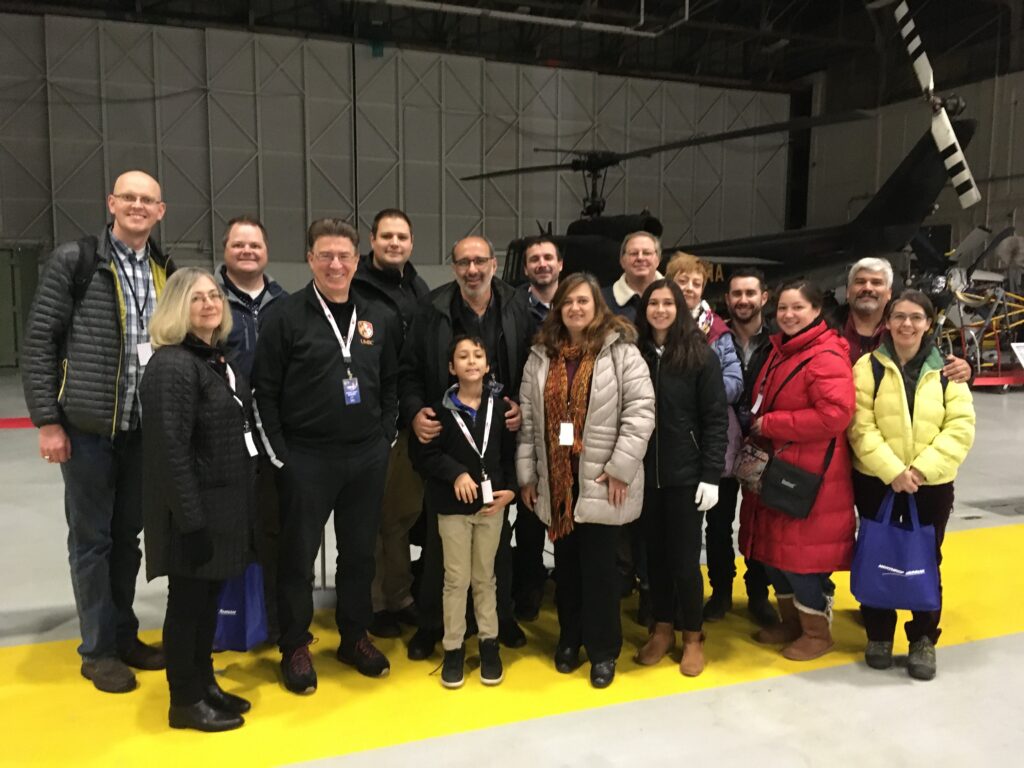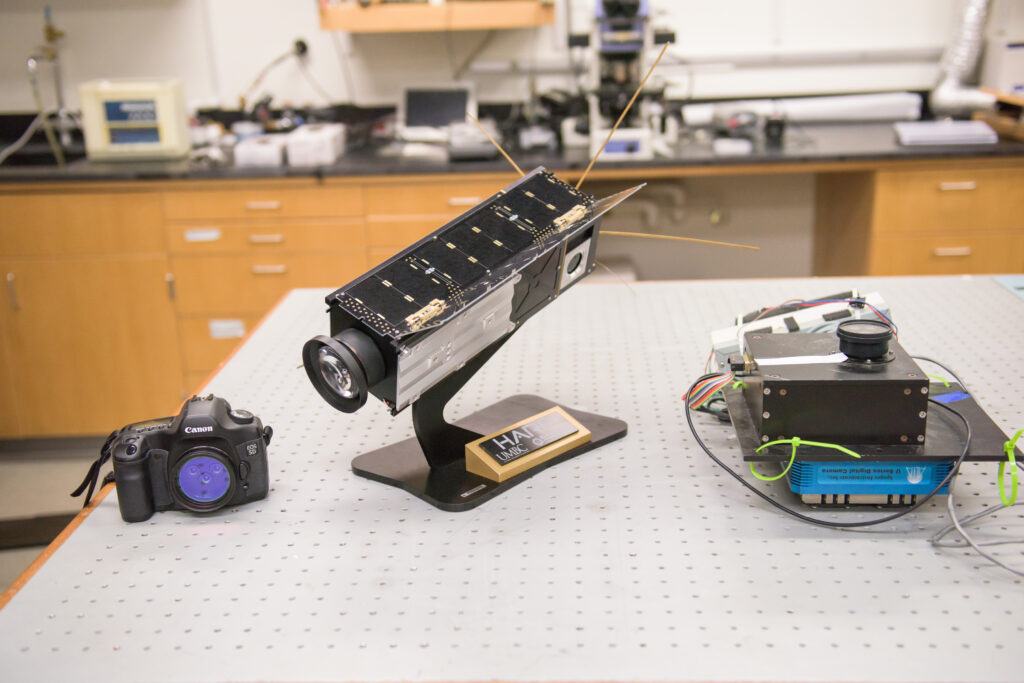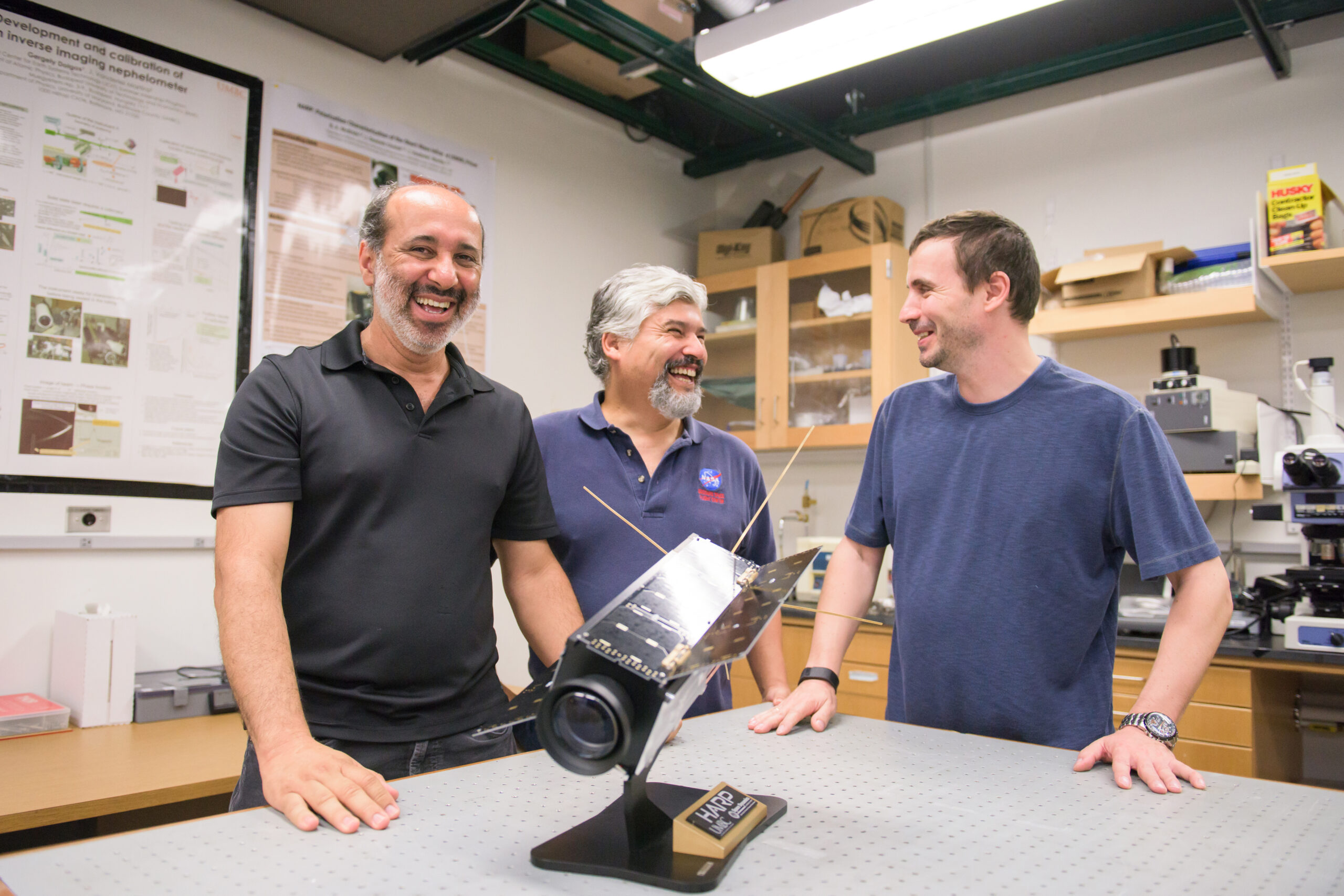UMBC’s Hyper-Angular Rainbow Polarimeter (HARP) Satellite, which began in Vanderlei Martins’s imagination more than a decade ago, has been flying in low-Earth orbit since February 19. It contains new technology that can collect detailed information about tiny particles in the atmosphere—previously unmeasurable data that will inform climate studies for years to come. The HARP team, including a large number of students, overcame obstacles at every step of the satellite’s journey to space, and its success is already being recognized.
On August 6, the American Institute of Aeronautics and Astronautics (AIAA) named HARP the Small Satellite Mission of the Year. To qualify as a “smallsat,” satellites must weigh less than 150 kg (330 lbs.). To win, a smallsat must demonstrate significant improvement in the capability of small satellites. That could mean advances in their structural design, scientific instrumentation, communications ability, or other factors.
A popular vote informed the AAIA SmallSat Technical Committee’s final decision. After voters selected HARP as a finalist, the smallsat went up against nine other finalists, including teams from the U.S., Guatemala, Singapore, and France. Votes for HARP poured in from all over the world, including ballots from 40 states and countries on six continents. In the end, HARP emerged as the winner.

A moment of joy
“I would like to thank the HARP team as a whole, because HARP is really the result of the perseverance of the team over many years,” said Martins, director of UMBC’s Earth and Space Institute, as he accepted the award. “There has been no shortage of problems, but we have always worked together to overcome them.”
HARP’s innovative design and ability to collect new kinds of data that will be crucial for future research sealed the win. The HARP instrument, designed and built by a UMBC team and funded by the NASA Earth Science Technology Office, is smaller than a loaf of bread. Yet, its pioneering polarimeter (the first ever in orbit) can measure certain properties of particles in the atmosphere for the first time, offering a new look at the properties of clouds and tiny particles in the atmosphere called aerosols. The first observation from HARP arrived back on Earth on April 16, and it’s been collecting data continuously since.
The small spacecraft developed by UMBC’s partners at Space Dynamics Lab (SDL) carried HARP to space, and the SDL team manages the satellite while it is in orbit. The whole satellite (instrument plus spacecraft) is the size of a large loaf of bread and only weighs about 6 kg (13 lbs.). UMBC shares the award with Space Dynamics Lab, which is affiliated with Utah State University.
“All of us at UMBC are so very proud of the efforts and the impact of Vanderlei Martins and the Earth & Space Institute,” says Karl Steiner, UMBC’s vice president for research. “Looking back at the launch of the HARP satellite at Wallops Island this past November, I know that today’s recognition as SmallSat Mission of the Year brings a much-needed moment of joy and encouragement to our campus community during a very different time.”

Student-driven success
The AIAA also gave out a People’s Choice Award (PCA) at the ceremony. The awards committee selects a PCA when a project has made substantial, unique contributions, but doesn’t necessarily meet the requirements for Mission of the Year. This year, Quetzal 1, Guatemala’s first-ever satellite, received the People’s Choice Award. Quetzal 1 has “opened the whole field of space science and technology in Guatemala,” shared Emily Clemens, awards committee chair.
Guatemala currently has no engineering graduate school programs and no space agency, noted Luis Zea, one of Quetzal 1’s co-directors, “but the students here accomplished something that I think is a good example of what young people can do when they set their minds to solving problems.”
Students are at the root of HARP, as well. The team has included scientists and engineers at every level. High school students, undergraduates, and graduate students all made important contributions in collaboration with faculty researchers.
“HARP is a small satellite, but we always had very big ambitions,” Martins says. At long last, those ambitions are bearing fruit. Some of the students who worked on HARP, and some new ones, are now at work on HARP2, which will build on technology developed for HARP. HARP2 will travel on the major NASA PACE mission, scheduled to launch in 2023. HARP2 will collect data that will inform studies of air quality, clouds, precipitation, and climate.
With only a tinge of disbelief, and a big smile, Martins says, “And that’s all due to this small satellite.”
Banner image: Core HARP team members Vanderlei Martins (left); Roberto Borda, assistant research scientist with UMBC’s Joint Center for Earth Systems Technology (JCET); and Dominik Cieslak, assistant research scientist with JCET. Photo by Marlayna Demond ’11 for UMBC.

